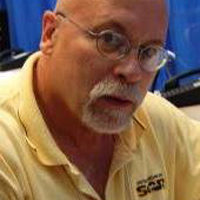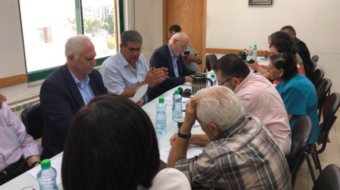
When I hired into the steel mill, Lorain Works–U.S. Steel in 1970, it was a monstrous place, smoking, churning out tons of steel, with thousands of workers going in and out almost constantly. Around 9,000 workers, they said.
The town of Lorain was/is an old mill town, with more bars than churches and more churches than whatever was next. I hadn’t known then there were as many different nationalities on earth as the number of different Nationality Clubs that were there.
The mill itself was over 700 acres, dominating the whole town, pushing out around eight million tons of steel a year. Lorain was said to have the nation’s third-largest Puerto Rican community, large Mexican and African-American communities, as well as huge numbers of first- and second-generation immigrants from every European country.

There was a history of left, working-class politics here. The town had a Socialist mayor in World War I, and the Communist Party had a long presence there, with the entire Steel Workers Organizing Committee (SWOC) joining the CP in ’42 when the union came to Lorain Works. For many years, a large CP club functioned at the mill, others in the committee, and there were Communist leaders in most major unions.
It was all damned intimidating to me when I started. Along with my new friend Miguel Torres, who worked his entire career there on the same job I had, I went to work nightshift, midnight to 8 a.m., in the Bar Mill. It was so overwhelming I remember going off into the racks to throw up. We were part of a big hiring wave, which is how mills hire workers. We were the “young guys” that were products of the ‘60s—the civil rights and peace struggles—and we figured we were going to change everything, and have fun doing it.
When we hired in, however, that left legacy that had marked Lorain Works had been brutalized, intimidated, and threatened down to George Edwards, who was a Machinist Instructor with around 28 years’ seniority. The rest of what had been a large, vibrant party and the wider left movement had seen arrests, firings, blacklists, blackmail, and threats as people were forced to turn on one another; progressive thoughts were driven behind closed doors.
But George stayed! No matter how he was threatened, he refused to buckle. He’d been part of the SWOC (after coming to Lorain to organize a “labor church”), founded United Steel Workers (USW) Local 1104’s newspaper, the Lorain Labor Leader, and the first veteran’s organization after returning from the fight against fascism.
2019 marks a century since the founding of the Communist Party USA. To commemorate the anniversary of the longest surviving socialist organization in the United States, People’s World has launched the article series: 100 Years of the Communist Party USA. Read the other articles published in the series and check out the guidelines about how to submit your own contribution.
He had a long, exemplary record of fighting against racism, having called for African Americans to be part of USW national leadership from the beginning, and singlehandedly broke all-white housing in nearby Amherst (that’s a different article). He was here, and here he’d stay!
George had reached out to some of us, raising the idea of developing something he called a “Rank & File Committee,” which sounded cool. We talked about what issues something like that could be based on or push for. We need big raises, and should push for young folks, Blacks, Hispanics, women to be reps, voting on our contract was key, some said. Health care for all (back then also), stop bosses from being able to fire us, and we need for all unions to be in one big union. We had great ideas!
Our union, USW Local 1104, and the International were still then dominated by folks who’d been heavily influenced by the red-baiting McCarthy era. We really felt they didn’t care what we wanted, nor did they really want us around at all.
Imagine our surprise a week later when we heard that George had been fired! Had it been government agents? Had he been set up? Had he been beaten up, arrested? We didn’t know, but we kept hearing it had something to do with some pink hard hat.
We eventually found out, and this is the real story.
As Machinist Instructor, George was in charge of teaching that trade to the young apprentices. The Machine Shop boss, an old conservative guy, markedly did not like civil rights, peaceniks, lefties, and especially did not appreciate young radical guys coming into his machine shop with their long hair and beards. He had a solution! He would harass these young punks, make them cut their damned beards off, and trim their hair back to “reasonable” lengths. All this was needed, he stated, for “safety.” The young apprentices were not happy, and they said so.
As it happened, the boss was walking by where George was eating lunch one day and noticed that George had painted his hard hat pink. “What the hell is that, Edwards,” he asked?
“Painted it to look like your bald head,” George answered. “I have to help those guys learn a tough trade, and all you’re doing is screwing stuff up. Leave them alone, and then I’ll repaint it!”
“You have until end of lunch break to paint it back or you’re fired,” the boss yelled.
Guess we all know now whether George jumped right up and painted that hat back or not!
However, U.S. Steel now had a real problem. They didn’t have the Machinist Instructor they needed. They also had a whole bunch of pissed-off young apprentices, and now the Cleveland newspaper had a front-page story about this guy with a perfect record, on a key job, that had nearly 30 years’ seniority who’d been fired by U.S. Steel because they didn’t like the color of his hard hat. This was negative, and they needed out from under it.
Immediately, the discharge was reduced to a three-day suspension, which they settled quickly in grievance procedure, with the suspension pulled and George paid for time lost.
More importantly, George got ahold of some of us and helped write up a leaflet calling a meeting to organize a Rank & File Committee. We had a packed hall, of mostly young folks, and when we left the room, the Committee had come into existence.
The interesting thing we learned—and it’s a lesson that I think is certainly still applicable today—is that the “perfect issue” to organize that movement around turned out not to be any of the big ideas we had; rather, it was what the workers themselves wanted to fight about. The important thing we found was that the most important issue always was what the workers were concerned about. If we’re there to help folks out when they needed help, if we’re there with others and bring all our power united to the issue, workers will turn back there when the next issue, and the next, come up.

From this seemingly insignificant little group of steelworkers there developed a multi-racial movement of workers that fought for and helped win transfer rights that were at the time denied to African-American workers. We won the right to vote on our contracts; we won more reps of color, and women, and overall, a fighting union that proudly stood for the principles that the SWOC fought for in the first place.
But, before I end this, I do think readers would appreciate one other, related little story.
As that Rank & File movement grew, new committees were set up and expanded at other mills. At the big Burns Harbor mill, one such committee emerged with future USW Local 6787 President Paul Kaczocha as one of their leaders. At a regional meeting of Rank & File folks in Cleveland, Paul, who was also a machinist, brought up that they had some new asshole boss who he heard was from Lorain that was harassing everyone. You guessed it, same guy!
Well, we had a bunch of leftover “George Edwards for President” stickers from the first election the Lorain group had run in. We gave those to Paul. The next time we saw him, he laughed like hell.
“You wouldn’t believe it,” he said. “Got the stickers to everyone, every worker in the shop, and when the boss came out for the morning meeting, he opened his mouth, said nothing, shut it, and turned around and went back into the office.”
The arm of working-class solidarity is a long one!












Comments